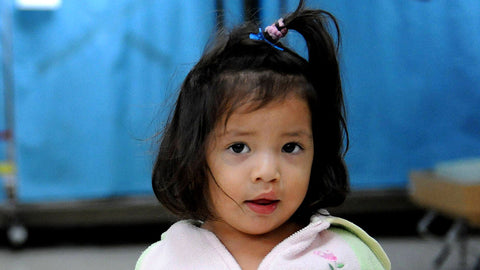Many adults have only barely noticeable scars to attest to the fact that they were born with a cleft defect. Children with these defects grow up to lead normal, productive lives.
About half of all clefts involve both the lip and palate. In 20% of cases only the lip is involved; the remaining 30% of clefts involve only the palate.
Treatment of cleft lip and palate should ideally involve a multidisciplinary team. Increasingly, hospitals have special teams that specialize in clefts and can provide treatment in all the areas that children with clefts will require as they grow.
Specialists who may be involved in your child’s care will include surgeons, speech and language therapists, dietitians, audiologists (hearing specialists), dentists, orthodontists, geneticists, psychologists, and specially trained nursing staff. Care of your child will begin immediately at birth and will continue until your child reaches adulthood.
Feeding
Feeding your child may be difficult immediately after birth, depending on the size and location of the cleft. Your child may have difficulty suckling at the breast or a bottle. Specialized equipment is available, including specially designed feeders, nipples, and bottle inserts. Your child’s ability to suck will be evaluated immediately after birth.
Children who have a cleft palate will need to be fed in the upright position. This is because the opening in the palate will allow milk to enter the nasal passage.
Hearing and Speech
Children with cleft defects may have speech and hearing problems as a result of their defects. At some point, your child may need a tympanostomy tube inserted to allow the ear to drain properly. This may prevent hearing loss and infections.
Speech problems may be treated by a speech-language pathologist on an ongoing basis as your child grows if speech is abnormal.
As the parent of a child with a cleft lip or palate (or both) you may be concerned about your child’s appearance.
Surgery to Correct Cleft Lip
Surgery to repair cleft lip may be done between 2 to 3 months of age. Surgeons generally prefer to wait until the patient is at least 10 weeks of age and weighs at least 10 pounds. Surgery is performed under general anesthesia and will take approximately 1 to 2 hours to perform (in most cases). Your child will likely only be required to stay in hospital for 24 hours. You will be shown how to care for your child after discharge from hospital, including wound care and feeding techniques. Your child will need to be prevented from touching the site of the operation. Special restraints may need to be used. Such restraints are not painful and are important to allow proper healing of the site. Your surgeon will discuss after care to you in detail before and after surgery.
Sutures will be removed in about 5 to 7 days, but it will take approximately 3 weeks for the operative area to be sufficiently healed.
More than one procedure may be necessary if the cleft is bilateral (occurs on both sides of the lip). If a second procedure is necessary, the second procedure will likely be done a few weeks after the first.
Surgery to Repair Cleft Palate
Your child’s cleft palate may be temporarily closed using a device called a palate obturator. This device is specially made to fit the roof of the mouth and covers the gap.
Surgery to correct cleft palate is usually performed between 6 and 12 months of age. More than 1 surgery may be needed as your child grows. Bone grafts are sometimes necessary if the cleft is extensive. These grafts can come from your own child.
Your child’s surgeon and orthodontist may work together to develop a plan for your child. Dental problems are common with cleft palates.
Psycho-Social Issues
Studies have shown that children with cleft lips or palates don’t perceive themselves as different until they reach school age. How they are perceived by their family is the most important indicator of developing healthy self-esteem. As a parent, you will be your child’s most important influence. Adolescence may be a difficult time for your child in terms of acceptance and self-esteem. Many teens are preoccupied with their looks, and differences in appearance can be upsetting for a teen. Being aware of this may help you, as a parent, to be alert for any signs of ineffective coping in your teen.
Children with cleft lips and palates can grow up to lead normal lives with only minimal scarring to attest to any difficulties they may have had to overcome in their early years.

